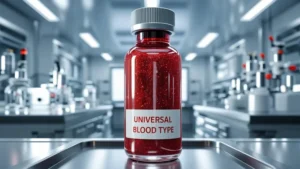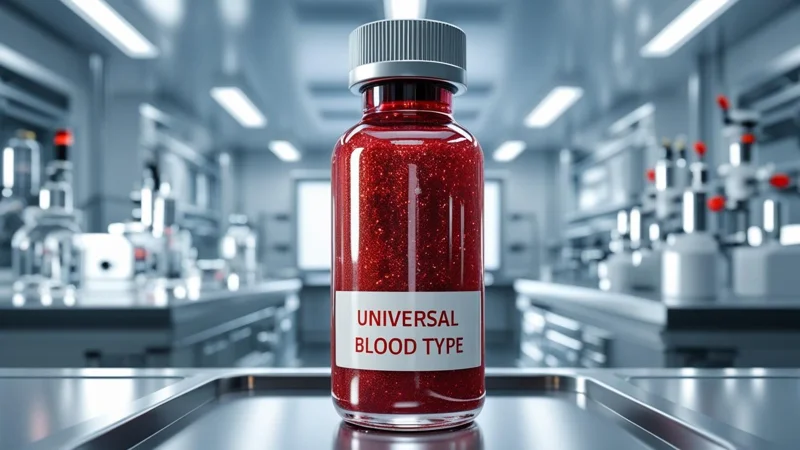Artificial Universal Blood : The Dawn of a New Era in 2025 The Incredible Promise
In the fast-paced world of medical innovation, few pursuits hold as much life-altering potential as the creation of artificial universal blood. For decades, the concept has felt like something plucked from the pages of science fiction. Yet, today, we stand at the precipice of a revolutionary breakthrough that could redefine emergency medicine, surgery, and patient care across the globe. The development of a safe, effective, and universally compatible blood substitute is no longer a distant dream but an accelerating reality, promising to solve some of the most persistent challenges in healthcare.
The need for such an innovation is undeniable. Blood is a precious, perishable resource. Its demand consistently outstrips supply, a problem exacerbated by stringent storage requirements, the necessity for blood type matching, and the ever-present risk of transfusion-transmitted infections. In rural areas, on the battlefield, or at the scene of mass casualty events, the logistical nightmare of providing the right blood to the right patient in time results in countless preventable deaths. A universally accepted, shelf-stable artificial blood would obliterate these barriers, offering a lifeline when and where it’s needed most.
This article delves into the remarkable science behind artificial universal blood, exploring the primary technologies driving its development, the immense benefits it offers, the significant hurdles researchers are working to overcome, and the incredible future it heralds for medicine.
Understanding the Science: How to Build a Blood Substitute
Creating a substance that can flawlessly mimic the life-sustaining functions of human blood is a monumental task. Real blood is a complex cocktail of cells, proteins, and platelets, each with a specific role, from oxygen transport and immune response to clotting. Current research into artificial blood primarily focuses on replicating the most critical function of red blood cells: oxygen transportation. Two main types of blood substitutes have emerged as the leading contenders: Hemoglobin-Based Oxygen Carriers (HBOCs) and Perfluorocarbon-Based Oxygen Carriers (PFCs).
-
Hemoglobin-Based Oxygen Carriers (HBOCs): This approach utilizes hemoglobin, the very protein that carries oxygen within our red blood cells. The hemoglobin is typically sourced from expired human donor blood, bovine (cow) blood, or created through recombinant DNA technology. However, free hemoglobin outside the protective shell of a red blood cell can be toxic, causing severe side effects like high blood pressure and kidney damage. To solve this, scientists are developing sophisticated methods to modify and stabilize the hemoglobin. This includes cross-linking the molecules, polymerizing them, or encapsulating them within synthetic shells called vesicles. A leading example of this technology is the “hemoglobin vesicle,” a microscopic lipid sphere containing purified hemoglobin, which mimics the structure of a real red blood cell but without the blood type antigens, making it universally compatible. Excitingly, as of early 2025, Japanese researchers at Nara Medical University have launched clinical trials for a hemoglobin vesicle-based product, a major step toward real-world application.
-
Perfluorocarbon-Based Oxygen Carriers (PFCs): PFCs are completely synthetic, inert chemical compounds that can dissolve vast amounts of oxygen. These are not water-soluble, so they must be emulsified—suspended as tiny droplets in a liquid—to be injected into the bloodstream. PFC particles are significantly smaller than red blood cells, which theoretically allows them to deliver oxygen to tissues in areas where blood flow is restricted, such as in a stroke or severe swelling. Unlike HBOCs, they are entirely man-made, eliminating the reliance on biological sources and the associated risks. While early PFC products faced challenges with side effects, newer generations are being developed with improved safety profiles.
The Monumental Advantages of a Universal Blood Supply
The successful development and deployment of artificial blood would be one of the most significant medical advancements in a century. The benefits are vast and transformative.
- Universal Compatibility: This is perhaps the most crucial advantage. Artificial blood lacks the A, B, and Rh antigens that determine blood type. This eliminates the need for cross-matching, saving critical time in emergencies. Any patient could receive it, regardless of their blood type.
- Long Shelf-Life and Stability: Donated human blood has a short shelf-life, typically around 42 days, and requires constant refrigeration. In contrast, many artificial blood prototypes, particularly in powdered form, can be stored at room temperature for a year or even longer. This dramatically simplifies logistics and allows for stockpiling in preparation for disasters or military conflicts.
- Safety and Purity: Each unit of donated blood must be rigorously screened for infectious agents like HIV, hepatitis, and other pathogens. Artificial blood, being manufactured in a controlled laboratory environment, is inherently free from these risks, ensuring a sterile and safe product. You can learn more about the strict standards for blood safety at the World Health Organization.
- Immediate Availability: In trauma situations, every second counts. The ability to have “blood on hand” in ambulances, helicopters, and remote clinics without worrying about refrigeration or blood type would revolutionize emergency response. This could drastically reduce mortality rates from hemorrhagic shock, the leading cause of preventable death in trauma patients.
Navigating the Hurdles on the Path to Approval
Despite the immense promise and recent breakthroughs, the road to creating a perfect blood substitute is fraught with challenges that scientists are diligently working to solve.
- Safety and Toxicity: The primary obstacle has always been safety. As mentioned, early-generation HBOCs showed a risk of vasoconstriction (narrowing of blood vessels) and kidney damage due to the toxicity of cell-free hemoglobin. Researchers are tackling this through advanced encapsulation and modification techniques to ensure the hemoglobin remains stable and non-toxic as it circulates in the body.
- Efficacy and Half-Life: An artificial blood product must not only be safe but also effective. It needs to carry sufficient oxygen and, crucially, release it to the tissues where it is needed. Furthermore, it must remain in circulation long enough to be therapeutically useful. Many current prototypes have a much shorter half-life in the body (hours to a few days) compared to natural red blood cells (up to 120 days). While this is sufficient for immediate emergency use, it makes them unsuitable for patients needing chronic transfusions.
- Scalability and Cost: For artificial blood to make a global impact, it must be producible on a massive scale and at a reasonable cost. The processes for purifying hemoglobin or synthesizing PFCs can be complex and expensive. Making the final product economically viable, especially for healthcare systems in developing countries, is a significant consideration. Finding an efficient manufacturing process is key to widespread adoption.
- Regulatory Approval: Proving the safety and efficacy of a new medical product to regulatory bodies like the U.S. Food and Drug Administration (FDA) is an exhaustive and lengthy process. It involves rigorous preclinical testing followed by multi-phase human clinical trials, which can take many years and substantial investment.
A Glimpse into the Future of Transfusion Medicine
The progress in recent years, particularly the initiation of human trials, signals that we are closer than ever to seeing artificial blood in clinical use. Japan aims for a practical rollout by 2030, a timeline that, if met, could inspire a global revolution in healthcare.
Initially, artificial blood will likely serve as a “bridge to transfusion” in critical emergencies, stabilizing a patient until they can receive a traditional blood transfusion in a hospital. Its use in military medicine, disaster relief, and rural healthcare will be invaluable.
Beyond emergency oxygen transport, the technology opens doors to other therapeutic possibilities. For example, the small size of some artificial blood particles could help deliver oxygen to tumors, making them more susceptible to radiation and chemotherapy. It could also play a role in organ preservation, extending the time an organ can be viable for transplantation.
The journey to create artificial universal blood is a testament to human ingenuity and our relentless pursuit of solutions to save lives. While challenges remain, the combination of biotechnology, nanotechnology, and dedicated research has put us on the cusp of a new era. The day when a paramedic can reach for a bag of sterile, universal, room-temperature blood to save a life at an accident scene is no longer a fantasy—it is the incredible future we are rapidly approaching.

Check out our latest posts !


